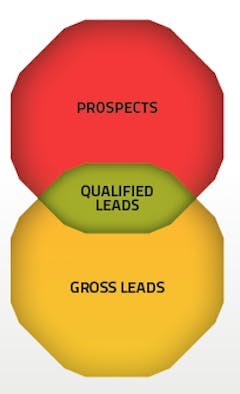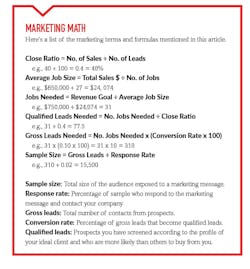Marketing is a weak spot for most remodelers. I’m not sure exactly why, but one theory is that when they first start out, work comes to them. They keep busy working from one word-of-mouth referral to another, so they never feel the need to go after new customers. Eventually, they may start using job signs or paint a logo on their truck. These are both great sources of leads, but they’re also limited in their ability to build a client base.
This wouldn’t be such a big deal if these small sole proprietors were selling to people who appreciated the value of their services and were earning a decent profit on every job. At least that would lead to a word-of-mouth chain of customers who were prepared to pay the going rate. But most start-up remodelers don’t realize that they’re working at a deep discount—or even at a loss—so they get stuck working the same type of project for the same type of client: one who comes into the relationship with price expectations based on word-of-mouth referrals.
It’s easy to blame the customer for this, but it’s the contractor who is at fault. Customers are looking for the best deal, but they have little experience buying remodeling. Price is an easy differentiator, so they focus on that, reinforced by the word-of-mouth phone tree of referrals from previous clients who got a good price.
In good times, this state of affairs can sustain itself and can even lead to growth, but in a haphazard way. When lean times arrive, as they always do, word-of-mouth dries up, and those jobs that are available are taken on at an even deeper discount. This cycle is part of the reason the failure rate of small remodeling companies is so high.
A better approach is to understand the types of projects and types of customers that consistently generate good profit, and do what it takes to find more projects and customers just like them. Referrals from these folks are still important, but so is a marketing strategy that continually works to attract similar prospects with remodeling needs that you know you can satisfy while earning a good profit.
A lot has to change to turn this situation around, including elements of sales, estimating, and production. But without a sound marketing plan, everything else succeeds by chance. The nuances of a marketing plan can get complex, but at the heart of it are two simple goals: identifying qualified prospects, and generating enough leads to meet revenue targets.
Qualified Leads
Every remodeling company should have an annual revenue target that is sufficient to cover project costs, salaries and payroll, and other overhead, such as insurance and legal fees, and that generates a decent profit. Ideally, that goal will be based on company history, including the average size and number of jobs sold annually, plus anticipated growth in the current year.
Close Ratio
Actual revenue depends on sales, which in turn depend on leads. One important relationship between sales and leads is called a close ratio, and the formula is pretty simple: SALES ÷ LEADS = CLOSE RATIO. For example, if you have 100 leads and sell 20 jobs, the close ratio would be 20 percent (20 ÷ 100).
But this example uses gross leads—that is, it counts everyone who contacts your company as a legitimate lead. We all know that not everyone who calls you is a serious prospect, so a better measure is net leads, or what I like to call qualified leads. Although it would be nice to have a consistent definition of this term so that companies could compare notes, unfortunately, what makes for a qualified lead means different things to different people. At the moment, however, what’s important is that you distinguish between a gross lead, which is a contact that you may not necessarily pursue, and a qualified lead, which is a prospect that meets enough criteria in your ideal client profile for you to spend additional time on follow-up.
That distinction often begins with a lead sheet, which is really nothing more than a series of questions that you ask of everyone who contacts your company about a project (see “Essential Lead Sheet Questions,” below). The goal is to screen out tire-kickers, prospects with inadequate budgets or unrealistic timetables, projects that aren’t in your service area or that aren’t as profitable for your company—in short, anything about the prospect or the project that doesn’t fit the way your company wants to work.
The result is a smaller number of leads, which affects the close ratio. For example, if you eliminated half of the prospects from the 100 gross leads in the previous example, your close ratio would improve to 40 percent (20 ÷ 50). This isn’t cheating; on the contrary, using qualified leads is a much more accurate way to measure sales performance. And for remodelers who have trouble saying no to potential work, it reinforces the practice of following up only with prospects that are a good fit for your business model.
Average Job Size
Now a couple of questions arise: How many qualified leads will you need to meet revenue goals? How many gross leads will you need to screen to yield that many qualified leads? Finding the answers involves some simple arithmetic using revenue, average job size, and number of jobs sold.
Let’s say, by way of example, that you want to increase sales from the $650,000 you sold in 2015 to $750,000 in 2016. [The difference between how much you sell and how much you produce is important, but it’s a question for another article.] How many jobs do you need to sell to meet that target? The depends on how big those jobs are, and your answer should be based on the actual average job size for the kinds of jobs you typically do. Easiest is to use last year’s average. For example, let’s say that in 2015 you sold 27 jobs; your average job size would be $24,074 ($650,000 ÷ 27).
Armed with this information, you can figure out how many jobs you need to sell to meet your 2016 revenue goal. The formula is: REVENUE ÷ AVERAGE JOB SIZE = NO. JOBS NEEDED ANNUALLY, you need to sell about 31 jobs ($750,000 ÷ $24,074); that’s about 2.6 jobs each month ($62,500 ÷ $24,074).
How Many Leads Are Enough?
You know how many jobs you need to sell, but how many leads is that? You already figured out that you close 40 percent of the qualified leads you pursue. To find out how many qualified leads you need to meet your targets, use the formula: NO. JOBS NEEDED ÷ CLOSE RATIO. In our example, this works out to about 78 leads per year (31 ÷ 0.40) or about 6.5 leads per month (2.6 ÷ 0.40).
Gross Leads
But wait a minute. Those are qualified leads, the ideal prospects that make it through your screening process. Unless your marketing campaign is 100 percent efficient, what you need to know now is how many gross leads it will take to attract 78 qualified leads per year. This depends on the conversion rate—the number of people who contact your company who become qualified leads. For the sake of our example, let’s say that 10 percent of the people who contact your company make it through your screening process. Here’s the equation: GROSS LEADS NEEDED = NO. JOBS NEEDED x (CONVERSION RATE x 100). Plugging in the values, you discover that you need 310 gross leads (31 x 10) to generate 78 qualified leads and 31 jobs at a close rate of 40 percent.
Sample Size
The last piece of the puzzle is about getting your message out. You want to know how many people you need to put your marketing message in front of to get 310 of them to contact you about a project. That called the sample size and it depends on the response rate, which can vary according to the message itself, the form it takes (email, postcard, job sign, etc.), who you send it to, how often you send it, and so on.
A rule of thumb says that an “outside mailing list” (a list you buy with names of people with whom you have no relationship) will generate a 2 percent response rate on average. When you plug that into the formula GROSS LEADS NEEDED ÷ RESPONSE RATE = SAMPLE SIZE, you discover that you need to reach 15,500 prospects (310 ÷ 0.02). Using a more targeted list, your response rate should be better: at 5 percent, you will have a sample size of 6,200; at 10 percent, 3,100.
This should make it clear that you don’t have enough past customers or referrals to generate the revenue you want to earn. That’s what marketing is for: It gets your message to prospects you don’t know and who don’t know you. Do that often enough and do it consistently, and you’ll have an easier time finding clients worth working for.
Essential Lead Sheet Questions
Whenever someone contacts your company, you should use a lead sheet to gather enough information to make a decision about taking the next step. Online forms are typically much shorter, so use the lead sheet during the follow-up call.
These questions get the conversation started, but you should follow up on anything that raises a red flag. Note that homeowners are often reluctant to reveal their budget. You should still try to get some idea about whether or not they are within range of what similar projects you’ve completed have cost.
- Where is the property? Is it a single-family home?
- Is it owner occupied? (If it’s a rental: Are you the owner?)
- What kind of project do you have in mind?
- Are you looking for both design and construction services? (If construction only: Who designed the project?)
- Are you talking with other remodeling contractors?
- (If “yes”: May I ask what companies?)
- Have you ever remodeled a home in the past?
- Do you have a start date in mind?
- When are you hoping the project will be completed?
- How much do you think a project like this will cost? (Alternative: How much were you planning to invest in this project?)
About the Author
Sal Alfano
Executive Editor
Sal Alfano is executive editor for Professional Remodeler. [email protected], 202.365.9070



